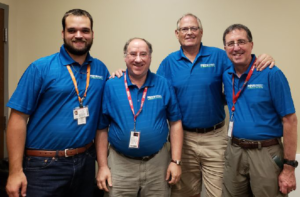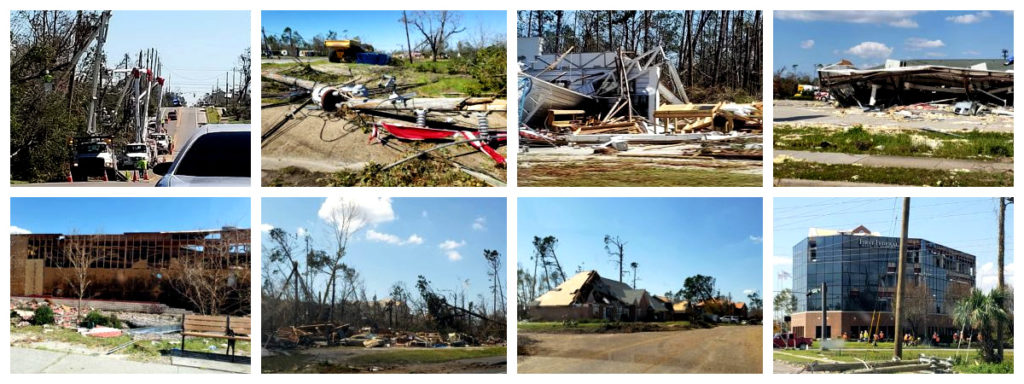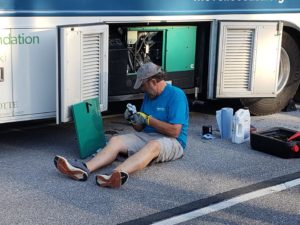
Hurricanes Florence and Michael ravaged much of the southeastern United States last autumn, setting new records for rainfall, wind speed and destruction.
After both disasters, IEEE-USA’s MOVE community outreach truck went into action, a welcome sight for both first responders, and the displaced people they help. As the MOVE team of trained IEEE members worked, they tallied some impressive statistics of their own: the five-person group of volunteers served a total of 118 people days – almost 17 weeks.
Moreover, their efforts were practically nonstop – on 8 October, after 3-1/2 weeks of assisting with Hurricane Florence disaster relief, the MOVE truck returned home to Raleigh. On 9 October, as Hurricane Michael set its sights on the Florida Panhandle, volunteers set out again.
Since its launch in 2016, the MOVE program has enabled members in Regions 3 and 5 to help deliver emergency assistance to victims of natural disasters, such as hurricanes, flooding and wildfires. MOVE’s volunteers provide temporary relief to the Red Cross and other disaster relief organizations; services include providing power in widespread outage areas; phone service via satellite, when cell phones and landlines are not available; and overall communications support that helps organizations function, and assists people in reaching the help they need.
At the heart of the initiative is the MOVE (Mobile Outreach VEhicle) truck. It’s equipped with a satellite to access the internet, a television connected via a small receiver on the roof to track storms, and the ability to simultaneously charge up to 120 cell phone batteries. As soon after a disaster as weather and road conditions permit, volunteers drive the truck to the affected area to support first responders’ relief operations. IEEE-USA sponsors the MOVE truck, with funds administered through the IEEE Foundation.
“Until early September, when Hurricane Florence intensified and took straight aim at the Carolinas, we’d had a very quiet year,” recalls IEEE Senior Member Grayson Randall, of Raleigh, N.C. Deeply involved with MOVE since its inception, as well as its launch in 2016, he has been the lead driver in the disasters where MOVE volunteers have assisted.
The “quiet year” changed with the storm’s arrival. By 13 September, more than 500,000 homes and businesses throughout the Carolinas had lost power, as strong winds downed trees and power lines. In addition to coastal storm surges, rivers crested at record heights everywhere else, flooding homes in some areas with as much as eight feet of water.

As thousands of people fled, many of them seeking safety in evacuation shelters, MOVE volunteers quickly arrived in Fayetteville, N.C., which served as Red Cross district headquarters. John Balsam, an IEEE Senior Life Member, served his first deployment after Florence hit. A few hours after arriving from his home in Atlanta, he was at work setting up the initial communications infrastructure for the Red Cross, with which MOVE is a partner.
In his two weeks with MOVE, Balsam also traveled with the team to several other North Carolina towns to establish communications operations at other shelters.
“In Lumberton,” he recalls, “300 people being housed in a high school hadn’t had communications services for five days. After we raised the MOVE satellite dish and offered phone communications services to everyone, it was amazing to see how being able to call family and friends, and just reconnect with the world, raised their spirits.”
Jay Diepenbrock, an IEEE Senior Member and three-year MOVE veteran, says his best memories of this year’s efforts also took place in Lumberton. “When we’re sent to a shelter, we provide our services to the staff and mostly interact with them,” he notes. ”But in Lumberton, we had evacuees coming to thank us and tell us how much the telephone service meant to them.”
Diepenbrock, who lives in Raleigh, got involved with MOVE in its earliest days. “I’d been doing short-term church missions and I attended an informational meeting about the program,” he remembers. “I like to solve problems, and the opportunity to use my technical skills to help others really appealed to me.”
Since his MOVE orientation in early 2016, he also has received special training to be a driver. “The first event I drove the truck to was the 2017 National Scout Jamboree in West Virginia,” he says. The MOVE truck is also used at science fairs and similar youth events to promote STEM careers and demonstrate real-world technology applications to students and their parents.
Another MOVE volunteer, Brian Greene of Raleigh, joined IEEE so he could participate in the program. In 2016, he volunteered with the Red Cross after Hurricane Matthew struck the southeastern United States. But after meeting the MOVE team, he decided he wanted to apply his technical background to the IEEE-USA program.
After Florence struck in September, Greene, who is a project engineer with Southern Industrial in Raleigh, got his boss to approve his taking one week off to volunteer with MOVE. His efforts did not go unnoticed; a few days into his service, he was told that he could take a second week.
According to Greene, it was time well spent. “I was in Wilmington almost a week, mostly helping out at the high school where people were being housed in the gym,” he says. “Providing internet and Wi-Fi access, in addition to power off the truck, helped them live as normal a life as possible.
“What I’ve gained through MOVE is huge,” he says, “and it’s helped me to grow as a person. The experience is very rewarding.”
Another MOVE volunteer, IEEE Life Senior Member Tim Forrest, got a late start helping in the Hurricane Florence recovery efforts. As he describes it, “I spent the first 20 hours of Florence enduring Florence.” The property of this longtime resident of Newport, North Carolina, suffered heavy flooding, including the loss of 40 trees. He volunteered the last week that the team was in North Carolina, going home briefly to repair his own home. Then, with Grayson Randall, he left for Florida the day after returning from Florence recovery.

Forrest and Randall agree that the devastation caused by Hurricane Michael was the worst they’ve seen. “When we arrived in Panama City, less than a day after the hurricane had made landfall, things were chaotic,” recalls Forrest. “There was no power or water, and just getting in supplies and setting up communications were very difficult.”

“This opportunity also became the first for us to use the MOVE truck in an environment for which it had been designed,” Randall says. “We ran the satellite 24/7, and the vehicle is air-conditioned inside, which made it comfortable for sleeping.”
When the generator on the truck required an oil change after operating around the clock for more than a week, Tim Forrest handled the job onsite – and became a hero. With the network operating on battery power during the oil change, services to the emergency shelter and the relief workers continued uninterrupted.
With some modesty, Forrest says he gets two things out of such contributions: “I like to keep the truck running, and I like helping people.”
Grayson Randall is the first to point out that MOVE volunteers don’t get any luxuries, and comfortable accommodations aren’t always assured. “In Panama City, we slept on cots in the van, and we ate MREs (Meals Ready to Eat) one night,” he says. “I don’t really notice the physical and emotional toll until I get home. But I have a good feeling because what we do is very rewarding.”
John Balsam calls his MOVE experience “very positive.” He laughs, “After my deployment, my wife and I took care of two young grandchildren for a week while their parents went on vacation. Sitting with our grandkids was more strenuous.”
More information about MOVE, and on how you can help, is at https://move.ieeeusa.org.
Helen Horwitz is an award-winning freelance writer who lives in Albuquerque, N.M. She was with IEEE from 1991 through 2011, the first nine as Staff Director, IEEE Corporate Communications.






